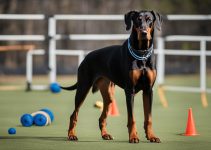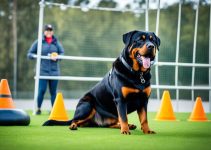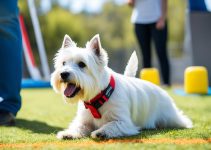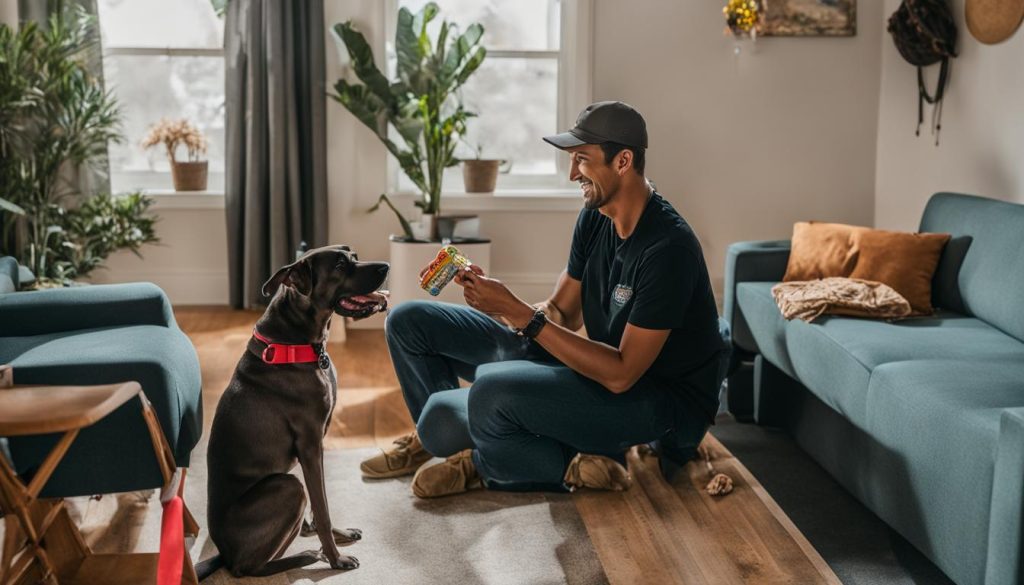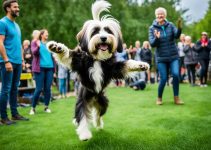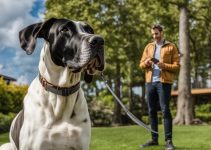Welcome to my blog where I share effective training tips for Great Danes, your gentle giants. Training a Great Dane can be a rewarding experience, especially when you understand the best training methods suited for their unique needs. In this article, I will provide you with valuable insights and techniques to help you train your Great Dane successfully.
Great Dane Training Techniques
- Start Great Dane training from an early age for better results and ingrained good habits.
- Understanding the Great Dane’s gentle and affectionate nature helps establish a positive training environment.
- Implement positive reinforcement techniques, such as rewards and praise, to motivate and reinforce desired behaviors.
- Address stubbornness and distractions with patience, consistency, and gradual exposure to challenging situations.
- Crate and leash training are essential for house training and ensuring your Great Dane’s safety and obedience.
Understanding the Great Dane Personality
Great Danes are beloved for their gentle and affectionate nature. These majestic creatures are intelligent, but their stubborn streak can sometimes pose a challenge in training. For a successful Great Dane training, it’s crucial to establish yourself as a confident and knowledgeable pack leader.
Positive reinforcement techniques, such as rewarding good behavior with treats and praise, are highly effective in Great Dane training. This breed responds well to positive associations, so make sure to create a positive and encouraging learning environment.
Additionally, socialization plays a crucial role in shaping your Great Dane’s behavior. It’s important to expose them to a variety of people, animals, and environments from a young age. This will help prevent aggression and ensure they grow up to be well-adjusted and friendly companions.
Understanding the Great Dane’s personality is key to tailoring your training approach. These gentle giants thrive on love, companionship, and positive interactions. With patience, consistency, and a deep understanding of their unique temperament, you can build a strong bond with your Great Dane while achieving successful training outcomes.
Positive reinforcement techniques for Great Dane training:
- Use treats, such as small pieces of cooked meat or dog-safe snacks, as rewards for good behavior.
- Offer plenty of verbal praise and enthusiastic encouragement to reinforce desired actions.
- Engage in playtime and interactive games as rewards for completing training exercises successfully.
By employing positive reinforcement and understanding the Great Dane’s personality, you can create an enjoyable and effective training experience for your gentle giant.
Starting Training at an Early Age
Training a Great Dane puppy from an early age is crucial for establishing good habits and behaviors. Starting training at around 8 weeks old sets a solid foundation for their development.
During the early stages of training, socialization plays a vital role in shaping their behavior. Great Danes are sociable dogs, but exposing them to different environments, people, and animals helps prevent fear or aggression issues later on.
Puppy training classes provide an excellent opportunity for socialization and learning basic obedience commands in a supervised setting. These classes allow puppies to interact with other dogs, helping them develop proper social skills and manners.
Short and frequent Great Dane training sessions work best for Great Dane puppies as they have shorter attention spans. Five to ten minutes a few times a day is sufficient to capture their focus without overwhelming them.
Consistency is key when training Great Dane puppies. Using positive reinforcement techniques like treats, praise, and playtime helps create a positive association with desired behaviors. Be patient and understanding, as it may take time for them to fully grasp and execute commands.
Remember, proper training and socialization from an early age will shape your Great Dane into a well-behaved and happy companion.
Essential Training Commands
Great Dane training involves teaching them essential commands that form the foundation for their obedience. By mastering these basic commands, you can establish effective communication and enhance your Great Dane’s training experience. Consistency, rewards, and positive reinforcement play vital roles in achieving success.
To begin, focus on teaching commands such as sit, stay, come, and heel. These core commands provide your Great Dane with important behavioral guidelines. Remember to use clear and consistent verbal cues along with appropriate hand gestures to reinforce the commands. Keep training sessions short and positive, ensuring that your Great Dane understands the expectations and feels motivated to respond.
- Sit: One of the most fundamental commands, “sit” teaches your Great Dane to maintain a seated position until given further instructions. Start by holding a treat close to their nose and gradually move it upwards, prompting them to lower their rear to the ground. Once they are in a seated position, reward them with a treat and praise.
- Stay: The “stay” command teaches your Great Dane to remain in place until given permission to move. Begin by asking your Great Dane to sit, then extend your hand towards them and say “stay” while taking a step back. Return and reward them after a few seconds of maintaining the position. Gradually increase the distance and duration as they become more comfortable.
- Come: “Come” is an essential command for your Great Dane’s safety and recall. Begin in a controlled environment, preferably indoors, and call your Great Dane’s name followed by the command “come.” Encourage them with an excited tone and open arms to entice them to approach you. Reward them generously when they reach you.
- Heel: Teaching your Great Dane to “heel” is important for walking politely on a leash. Start by standing on the left side of your Great Dane and encourage them to walk close to your side. Use the command “heel” and reward them for maintaining the desired position, either with treats or verbal praise.
Additionally, there are other useful commands that are beneficial for your Great Dane’s training:
- Leave it: Teaching your Great Dane to “leave it” helps prevent them from picking up harmful objects or engaging in unwanted behaviors. Start by presenting a treat in your closed hand and say “leave it.” Wait for them to lose interest in trying to access the treat, then reward them with a different treat.
- Drop it: The “drop it” command is essential for your Great Dane to release objects from their mouth. Begin by offering a toy or item with a firm grip. Say “drop it” and wait for them to release it willingly. Once they drop the item, reward them with praise and a treat.
- Wait: Teaching your Great Dane to “wait” helps create boundaries and prevents them from rushing through doors or jumping out of the car. Start by having them sit in front of a door or in the car and say “wait.” Gradually increase the duration and reward them for their patience.
- Off: The “off” command is useful for preventing your Great Dane from jumping on people or furniture. Whenever they display the unwanted behavior, calmly say “off” and redirect their attention to an appropriate alternative. Reward them for responding appropriately.
Remember, Great Dane training is an ongoing process. Consistency and positive reinforcement are key to reinforcing the commands and achieving desired behaviors. With patience, practice, and love, your Great Dane will become a well-trained and obedient companion.
Positive Reinforcement Training
Positive reinforcement is a highly effective training method for Great Danes. It involves rewarding your dog’s good behavior with treats, praise, and playtime, creating a positive association with the desired behaviors.
When your Great Dane exhibits good behavior, such as following commands or displaying proper manners, it’s important to provide immediate rewards. This reinforces the positive behavior and motivates them to continue behaving well.
Consistency is key when using positive reinforcement. Be sure to reward your dog every time they exhibit the desired behavior. This helps them understand that their actions result in positive outcomes, encouraging them to repeat those behaviors in the future.
Positive reinforcement training helps build a strong bond between you and your Great Dane. When you reward them for good behavior, they associate you with positive experiences, fostering trust and a cooperative attitude during training sessions.
In addition to treats, praise, and playtime, you can also use other rewards that your Great Dane finds motivating, such as their favorite toys or access to activities they enjoy. Tailor the rewards to your dog’s preferences to ensure their continued engagement and enthusiasm.
Remember, positive reinforcement training is not about giving your dog a treat for every action they take. It’s about selectively reinforcing behaviors that you want to encourage.
By consistently using positive reinforcement and rewarding good behavior, you can effectively train your Great Dane and create a harmonious relationship based on trust, respect, and positive association with their behavior.

Dealing with Stubbornness and Distractions
Great Dane training can sometimes be challenging due to their stubbornness and tendency to get easily distracted. However, with patience, consistency, and the right approach, you can overcome these training challenges and ensure success.
When working with a stubborn Great Dane, it’s important to avoid frustration and anger. Instead, remain calm and firm in your training methods. Negative reinforcement techniques can often have the opposite effect, so stick to positive reinforcement. Using treats and praise as rewards will motivate your Great Dane to listen and follow commands.
In addition to dealing with stubbornness, distractions can also pose a challenge during training sessions. Great Danes are naturally curious and can get easily distracted by their surroundings. Gradual exposure to distractions is key. Start training in a quiet and controlled environment, then gradually introduce distractions such as toys or other pets. This will help your Great Dane learn to stay focused even in the presence of distractions.
It’s also beneficial to incorporate a variety of training techniques to keep your Great Dane engaged. Mix up your training routine with obedience exercises, agility training, and interactive play sessions. This will stimulate their mind and prevent boredom, making them more receptive to training.
Remember, dealing with stubbornness and distractions requires patience and consistency. Stay positive, use rewards, and keep your training sessions enjoyable for both you and your Great Dane. With time and effort, you’ll see progress and develop a strong bond with your gentle giant.
Crate and Leash Training
Proper crate training is essential for house training your Great Dane and preventing destructive behavior. The crate should be the right size, providing enough space for your dog to stand, turn around, and lie down comfortably. Place the crate in a well-ventilated area, ensuring it is clean, safe, and comfortable for your Great Dane.
Leash training is crucial for your Great Dane’s safety and obedience. Invest in sturdy leashes that can withstand the strength of your large breed dog. Avoid retractable leashes, as they may not provide enough control during training sessions. Remember to always attach the leash to your dog’s harness or collar securely before starting the training.
A common mistake many owners make is pulling on the leash when their dog starts pulling or lunging. Instead, use proper leash training techniques such as stopping or changing directions to redirect your Great Dane’s attention back to you. Rewarding your dog with treats and praise for walking calmly beside you will reinforce the desired behavior.
Tips for Successful Crate and Leash Training:
- Introduce the crate gradually, making it a positive and comfortable space for your Great Dane. Use treats or toys to encourage your dog to enter the crate willingly.
- Start with short leash training sessions in a quiet and familiar environment to minimize distractions. As your Great Dane grows more comfortable, gradually introduce different environments and increase the duration of the sessions.
- Practice walking on a loose leash, rewarding your dog for staying by your side rather than pulling. Use positive reinforcement techniques consistently to reinforce the desired behavior.
- Be patient and consistent with the training process. Remember that each dog learns at their own pace, and it may take time for your Great Dane to master crate and leash training.
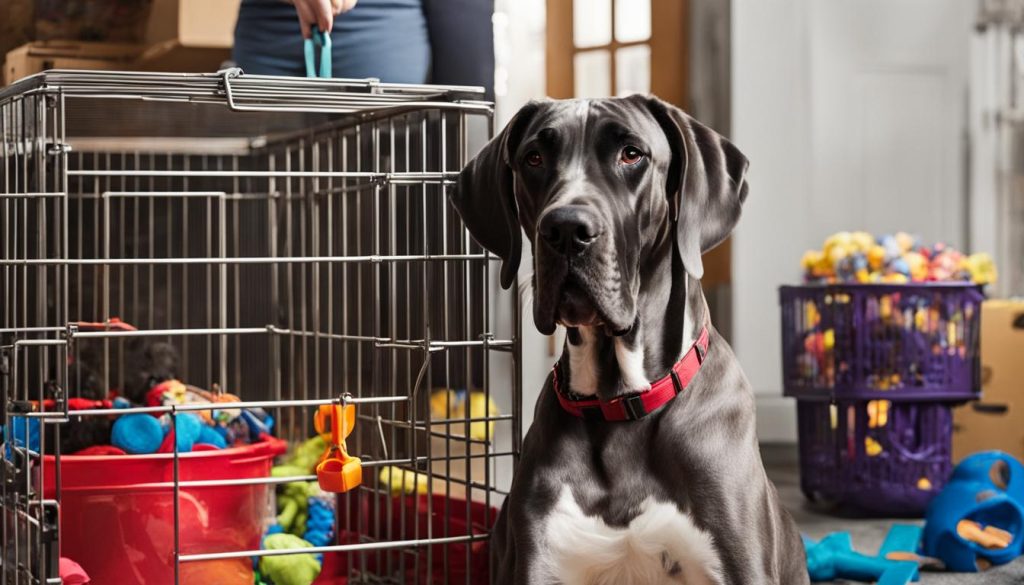
With proper crate and leash training, you can ensure your Great Dane’s safety, prevent unwanted behaviors, and establish a strong bond between you and your gentle giant.
Conclusion
Training a Great Dane requires knowledge, patience, and consistency. By starting the training process from an early age and understanding the breed’s unique personality, we can set our gentle giants up for success. Utilizing positive reinforcement techniques, such as rewards and praise, helps create a positive association with desired behaviors and strengthens the bond between owner and dog.
Addressing stubbornness and distractions is essential in overcoming training challenges. Remaining calm and firm, and utilizing various training techniques, can keep our Great Danes engaged and focused. Additionally, crate and leash training are vital for their safety, obedience, and overall well-being.
If you’re in need of professional Great Dane training services, consider reaching out to reputable trainers who specialize in these gentle giants. They can provide successful training programs tailored to your dog’s needs and ensure that you develop a well-behaved and happy companion who brings joy to your household.
FAQ
Are Great Danes easy to train?
Yes, Great Danes are generally easy to train due to their people-pleasing nature and response to positive reinforcement.
How should I start training my Great Dane?
It is beneficial to start training your Great Dane puppy from an early age. Basic obedience training should be started at around 8 weeks old. Puppy training classes are recommended for socialization.
What are some essential training commands for Great Danes?
Some essential training commands for Great Danes include sit, stay, come, and heel. Mastery of these basic commands lays the foundation for more advanced training.
What is positive reinforcement training and is it effective for Great Danes?
Positive reinforcement training involves rewarding desired behaviors with treats, praise, and playtime. It is an effective training method for Great Danes and helps create a positive association with good behavior.
How do I deal with stubbornness and distractions during training?
Great Danes can be stubborn and easily distracted. It is important to remain patient and consistent with training techniques. Gradual exposure to distractions and the use of various training methods can help keep your Great Dane focused.
Is crate training and leash training important for Great Danes?
Yes, crate training is important for house training and preventing destructive behavior. Leash training is crucial for your Great Dane’s safety and obedience. Proper techniques and consistency are necessary for both crate and leash training.
What are the key tips for successful Great Dane training?
Starting training from an early age, understanding the breed’s personality, using positive reinforcement techniques, and addressing stubbornness and distractions are key tips for successful Great Dane training.

